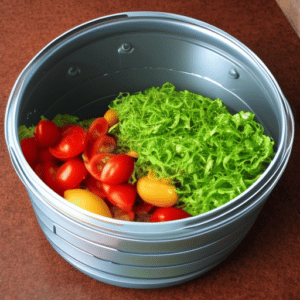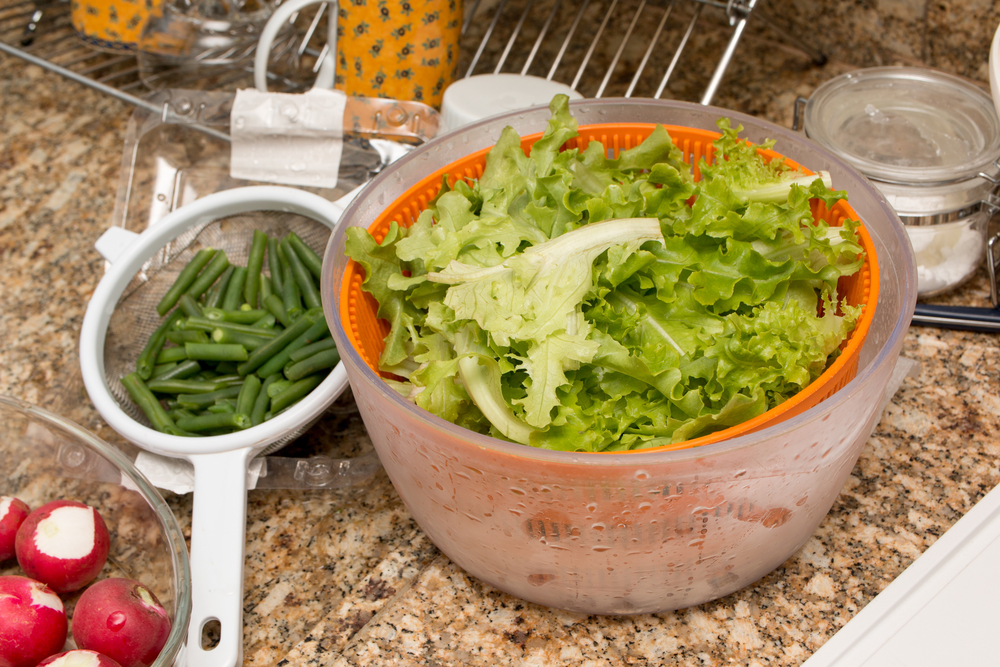Most of us prefer kitchen appliances that help us declutter our kitchens. However, we can make an exception when it comes to a salad spinner. In this article, we will be looking at how to use a salad spinner to prepare a variety of delectable salads. Let’s get started!
What Is a Salad Spinner?
This simple yet clever kitchen tool is used to wash and dry salad ingredients. Generally, it comprises three main parts: A salad spinner bowl, a colander and a lid with a spinning mechanism.
Usually, the spinning mechanism on the lid that causes the colander to spin is activated by pushing on a lever or turning a handle.
Moreover, the centrifugal forces on a salad spinner ensure that the water separates from the healthy greens and propels through holes in the basket into the surrounding bowl. Note that the fast rotation action helps remove water quickly and effortlessly.
Step-by-Step Guide to Using a Salad Spinner
Are you using your salad spinner to rinse and spin dry your vegetables only? If yes, then you’re missing out. But worry not. We’re going to take you through a step-by-step guide on how to use a salad spinner.
Note: When using salad spinners, the key is to allow your greens to soak. This allows all the dirt to fall at the bottom of the bowl.
With that in mind, here are the detailed steps of using a salad spinner that will ensure you end up with clean, crisp and fresh lettuce, herbs or greens.
Step 1: Preparing Your Greens
Before you put your salad spinner to the test, start by preparing your preferred greens or lettuce that you will be using on your salad spinner. It’s always advisable to prepare a large batch even though you won’t use them immediately.
Keep in mind that once you’re done with the below steps, you will only place what you will use in a salad bowl. Then store the rest in the crisp drawer of your refrigerator for later use.
Step 2: Place Greens in the Spinner
Once you’re done preparing your salad leaves, place them in the basket of the salad spinner,
Step 3: Submerge the Salad Leaves in Water
For this step, you will be required to submerge the salad greens in water. Note that you will be soaking at this stage and not rinsing.
Ensure that you fill your salad spinner bowl with cold water until fully covered with all the greens. Moreover, you can add ice cubes to the bowl to make the water colder, as this helps make the greens extra crispy.
Step 4: Soak for 5 Minutes
Allow your salad leaves to soak for about 5 minutes before you begin spinning. Allowing the vegetables to settle in water for a while helps the dirt settle at the bottom of the bowl. In the meantime, you can prepare your salad dressing as well.
Step 5: Empty Bowl and Spin
Once the soak cycle is complete, it’s time to spin. Gently remove the basket from the bowl and pour out any excess water from the bowl. Place the basket back in place, the lid back on and spin.
After giving it a few cranks, press the brakes on your salad spinner. Then remove the basket from the spinning bowl and pour out the water.
Repeat this step twice until no water is left in the bowl after spinning.
Step 6: Storing the Greens
Once you’re done cleaning your veggies, you can store the excess leaves that you will not use in an airtight container or bag in your refrigerator.
Keep in mind that green vegetables usually stay fresh for about 2-3 days, depending on their freshness in storage.
What Are the Different Types of Salad Spinners
All salad spinners boast the same primary components– bowl, strainer basket, lid, brake, and spinning mechanism.
However, the difference in salad spinners sits in their spinning mechanism. With that in mind, let’s take a look at the different types of salad spinners UK stores have to offer:
- Pump button – Comes with a button on the top of the lid that allows you to pump to spin
- Crank – Has a similar working mechanism to that of a pasta maker
- Cord – It has a cord that resembles that of a loan mower. The cord is used for spinning the basket.
Note: Regardless of the mechanism a salad spinner comes with, its primary function remains constant. To quickly wash and dry leafy vegetables.
Salad Spinner Key Features
While the technology of this nifty gadget is similar to that of a merry-go-round, multiple manufacturers have come up with different ways to make their salad spinners stand out from the crowd.
However, when shopping for one, here are some of the features you should look out for.
Size and Capacity
Always consider the capacity a salad spinner holds. Keep in mind that the larger the salad spinner’s capacity is, the easier the salad preparation is. Nonetheless, a large salad spinner takes up more kitchen and storage space.
What Is the Best Size of a Salad Spinner?
This typically comes down to the number of salad servings you will be preparing. If you’re looking forward to preparing single portions for two people, then a salad spinner with a capacity of 2.5 litres will get the job done.
However, if you’re preparing larger portions of salads for a big gathering, then you should settle for a 5L salad spinner that can wash up to 6 portions of vegetables.
Cleaning
Cleaning is another factor you should always consider when shopping for a salad spinner. Ensure that you settle for one that is easy to assemble and disassemble during cleaning. Optionally you can settle for one that is easy to clean without the need to take it apart.
Ease of Use

When shopping for a kitchen gadget, it’s always essential to consider its ease of use. Ensure that you go for a straightforward appliance that doesn’t require you to go down the rabbit hole of understanding its working mechanism. And this should also apply when selecting your ideal salad spinner.
Always settle for one that comes with a fitting lid, a base bowl and a spin cycle that works efficiently and a breaking mechanism that effectively stops the spinning.
What Are the Benefits of Using a Salad Spinner?
Gone are the days when you had to prepare your favourite salads with waterlogged lettuce. It is even much better if you find dirt between your leafy greens. You need not worry about it if you own a salad spinner. With that in mind, let’s look at some of the pros and cons of salad spinners.
Pros
- Crispier and fresher-tasting greens
- Easy to use
- Quick and efficient for washing greens
- Easy to clean
Cons
- Some may require an ample storage space
- Some may come with lots of bits and pieces to keep track of
Other Uses for a Salad Spinner

While salad spinners provide an easy way of cleaning leafy greens, you can also use them for other purposes. They come in handy if you’re looking forward to draining liquids from any ingredients that can fit in your salad spinner.
Here are other common uses of a salad spinner:
- Straining seeds and liquid from canned beans and canned tomatoes
- You can use it to clean non-leafy veggies like broccoli and cauliflower
- Soaking dried beets
- Removing water from cooked potatoes
- Soaking and rinsing beans
- You can use it as a spare serving bowl
- Soaking and spinning pasta
Use Your Salad Spinner Properly
That is it on how to use a salad spinner. We hope that this article can help put your newly earned skills to the test by preparing various salad recipes.
Do you own a salad spinner and use it for other purposes? Or do you have any other tips? Let us know, and leave a comment below!

